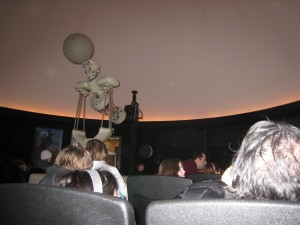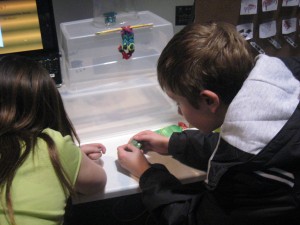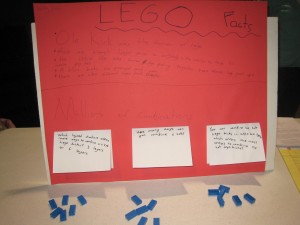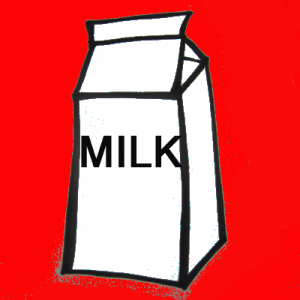Category:The World Around Us’
Endeavour’s Name
- by KitchenPantryScientist
I was thrilled to get my first question from a student named Ian yesterday! He asked how the space shuttle Endeavour got her name.

When NASA invited students to name the new shuttle they were building, over 70,000 kids replied to the challenge. You can read more about the contest on NASA’s website, but here’s why Endeavour was the winning name:
“Endeavour was the most popular entry, accounting for almost one-third of the state-level winners. The Endeavour was a ship belonging to the British Royal Navy. In their entries, students focused on the vessel’s first voyage under the command of seaman and scientist James Cook in 1769-71. Cook steered Endeavour to Tahiti in the South Pacific to observe and record the rare event of the transit of Venus, a celestial event that allows observers on Earth to see Venus passing across the face of the sun.
Students drew parallels between astronomy on Cook’s Endeavour and on the space shuttle; the payloads of medicine, science and commerce that were on both the ship and shuttles; and the make-up of the crews, both of which included scientists.” www.nasa.gov
A great name, don’t you agree?
NASA, Twitter and LeVar Burton
- by KitchenPantryScientist
What do they have in common? Read on…
I never win anything. Never.
But last week I got an email saying I’d won a coveted spot in NASA’s Tweet-up for STS-134. In English, this means that I get to join 149 other lucky winners (including LeVar Burton of Star Trek/Reading Rainbow fame) to spend April 18th and 19th at Kennedy Space Center. If all goes according to plan, my Twittermates and I will get to witness the final launch of space shuttle Endeavour as the sun sets over the Florida coast.
Even better, we get front row, “VIP” seats at the launch with the media and have our own tent with A.C. and WiFi where we can tweet away as we listen to amazing speakers from NASA and the shuttle program.
I’ll set up my blog so you can easily follow my tweets online here as I tour Kennedy Space Center and follow the events leading to the launch! Please feel free to email or tweet me any questions you have about the space program so I’ll have lots of good questions for the speakers! If you’d prefer to follow me on Twitter, you can find me under KitchPantrySci.
I’ll be posting some fun propulsion experiments between now and then, so get ready to rocket!
Seeing Stars
- by KitchenPantryScientist
My son is obsessed with UFOs. Every time we go outside at night, he scans the sky for moving spots of light. I tend to be dismissive, brushing off his imagination like a pesky fly, worried that he won’t go to sleep for fear of an alien invasion.
It’s not that I’ve discounted the possibility that there may be intelligent life elsewhere in the universe (I love Star Trek as much as the next geek), but it’s always seemed unlikely to me, and not worth much thought.
A field trip to the planetarium with my son’s class last week gave me new perspective though. After the requisite, but fun voyage through the constellations we see from our own green and blue planet, our guide turned on a second projector. We virtually zoomed away from earth, escaped our tiny solar system, and flew out of our galaxy to view a dazzling array of billions of galaxies sparkling like jewels in the vast universe.
I walked out of the dark room in a daze, feeling like a speck of cosmic dust and filled with absolute certainty that my 10-year old is much smarter than I am. Last night I caught myself scanning the night sky, imagining aliens. It made me smile.
It Takes a Village
- by KitchenPantryScientist
I did Q&A’s with a few winners of the Children’s Defense Fund’s “Beat the Odds” scholarship winners and was inspired by their stories. Here is one of them:
“ I am standing before you as the living metaphor, a reminder of kids that grow up in war zones, of kids that grow up without childhoods; of kids in need of a home, a father or mother, and of kids without futures, unless those of us who have the power to change their lives are willing to take action.” Wesley Alcenat at the 2006 “Beat the Odds” celebration.
“If it takes a village to raise you, it will take a village to also help you succeed. Don’t believe the hype or the myth that tells you to raise yourself by your bootstraps. No one in this world makes it by raising themselves by their own bootstraps. Just as it is logically and physically impossible to do that, it is impossible to find success without combining a sense of personal responsibility with the support, love, and the nurturing of a community.” Wesley Alcenat in my interview with him last week.
Westenley came to the United States from Haiti, where both his parents were killed by soldiers and he witnesses countless atrocities. With the help of his grandparents and a supportive educational system, Wes was able to overcome his past and move forward in life, but never forgot where he came from and others like him who suffer so much. His amazing story continues today.
How do you like college? What are you studying and what’s your favorite class at the moment?
Although I am currently out of college, I am still in the college setting and love it very much. I graduated in May 2010 with a bachelor in Political Science/History. I am attending Columbia University in New York, where I am enrolled in the American History program as a Ph.D candidate. At the moment, I enjoy my class on American politics, called “Themes in American Political Development.”
Are you involved in any extracurricular activities or volunteering?
Outside of school I am part of a school reform program in which graduate students like me are paired with high school and junior high teachers teaching American history. The hope is that I will get an idea for what it’s like to teach and in the process teachers will benefit from my “expertise” in history. As of a week ago, I began taking Tango classes on Thursday nights.
I just read your bio and was especially interested to see that you’d eventually like to receive a Master’s Degree in Public Health, which seems especially relevant in the wake of the cholera epidemic currently causing so many problems in Haiti. Are you hoping to work with diseases like cholera related to poverty, or have you changed directions?
That’s a good question. My interests are diverse and constantly evolving. While I am still interested in Public Health, I have changed course. I am still deeply interested in issues of social justice, philanthropy, and the well-being of the poor and the vulnerable. This interest led me to take a role in helping to find funds to help earthquake victims in Haiti while I was still in college. I don’t believe that I will ever lose my love of service. That is why I aspire to someday end my life in the non-profit sector, either as an official of a non-profit organization or a key player in some other way, shape or form. I am driven by the crusade to end or alleviate poverty; if not poverty, than the ending of systemic impoverishment as we know it. Abject poverty is inhumane, unacceptable and from my perspective, something we can completely eradicate if the will is there. My direction to education sustains this position as I believe education is the most effective and perhaps proven tool for tackling poverty and provides the most returns of any type of social reforms.
What are some of your dreams for the future?
As a follow up to the answer to your question above and also to answer this question: Rerouting my ambitions to academia has invited skepticism by family and friends alike that there is no place for academics in social change/justice. I disagree emphatically about this notion that intellectuals are engage in the pursuit of things disconnected from the everyday concerns of practical life. Nothing can be farther from the truth. My decision to study history is embedded in my long-term interests with the practical concerns of education, economic justice, and producing model citizens for a democratic society. Although my interests in political life and philanthropic service is still very strong, I believe I will be most useful when I can connect my aspirations for a future of progress with the knowledge that our struggles right now in the present are a result of our past failures. How better of a country would we be if every politician could echo this point. Instead, we’ve seen a culture of anti-intellectualism that is in itself a shorthand for maintaining the status quo. And that means, further deteriorating the very conditions that organizations like CDF has for decades tried to ameliorate. How can we try to reform society without knowing why reform is needed in the first place? History is memory, and a nation without memory is a country without any collections of who it is, what it is, and ultimately it doesn’t know itself. That is why I believe in the long-term, my education will prove to be an investment in making me a better public servant in whatever capacity, wherever and whenever that opportunity may arise in the future.
What advice would you give kids struggling with adversity to help them succeed as you have?
Although I hate to simplify, any kids who can make good on their understanding and execution of the following quotes will have increased their chances at succeeding in their endeavors:
“Education is our passport to the future, for tomorrow belongs to the people who prepare for it today…Of all our studies, history is best qualified to reward our research” -Malcolm X (Malcolm is not saying that you have to become a historian, but that it’s almost impossible to know where you need to go, if you don’t know where you are coming from.)
“Education has in America’s whole history been the major hope for improving the individual and society.” -Gunnar Myrdal
Helping Others Beat the Odds
- by KitchenPantryScientist
Social, cutural and economic hurdles make it difficult, if not impossible, for many American students to succeed in school and go on to attend college.
Lily Moua, a 2002 recipient of a “Beat the Odds” scholarship from the Children’s Defense Fund of Minnesota, first tackled the issue of Hmong girls and education head-on when she was in high school. Setting up meetings between parents and students in her community allowed Hmong students to explain the importance of extracurricular activities for educational opportunities to their parents, while giving parents a place to voice their fears of cultural abandonment.
Lily is the sixth of 12 children of Hmong immigrants who struggled to face the challenge of becoming a member of American society while respecting the wishes and culture of her parents. Although her parents realized the importance of education, they expected Lily to come home after school and fit into the traditional Hmong girl’s role where she should help around the house and have no goals beyond marrying and raising a family. In an essay for the Beat the Odds scholarship program Lily wrote, “I had a vision about how remarkable it would be if the language and culture barriers between parents and students improved and if a system of support and trust could be built between parents and students.”
Lily went on to attend St. Olaf College in Northfield, MN. I interviewed her last week about her college experience and what she’s doing today.
What did you study at St. Olaf? Sociology and Anthropology Major. Management and Asian Studies Minor. I studied aboard in China, Thailand, Vietnam, and Tanzania.
Were you involved in any extracurricular activities, or did you do any volunteer work? Yes. I was extremely busy leading, teaching, and dancing on campus. I also mentored and tutored a number of students on and off campus and served on three non profit boards and committees. I continue my same legacy in college like in high school where I taught Hmong college students how to speak, read, and write Hmong so that they can be comfortable and confident in their bicultural abilities. In addition, I taught the students how to appreciate their culture and their parent’s sacrifices. We had annual Hmong appreciation banquets where Hmong parents got to learn about the experience of going to college and we shared with them our appreciation for our culture and heritage–this became a great bonding experience for parents and their son/daughter and a good recruiting mechanism for St. Olaf.
Did you go on to medical school, or were you inspired to take a different path? After I started college, I decided that I wanted to travel and study abroad as much as possible. Studying pre-medicine did not allow me to be flexible or to explore my life/career passions. It was the end of my freshmen year that I decided I did not want to dedicate my life to studying medicine. I found my love for studying people, cultures, places, structures, and organizations while studying abroad and making sense of my interests in college. I discovered that I wanted to do many things and explore multiple careers that allowed me to leave a legacy, make a difference in numerous ways, impact larger communities and societies, and where I can live well plus have a healthy and fun life style. After graduating and working for Target Corporation, I continued on to pursue my masters degree in public policy.
What are you doing now? Now, I work for the US Dept of Agriculture-APHIS where I do HR classification to help the agency protect agricultural health, regulate genetically engineered organisms, and administer the Animal Welfare Act. I advise and work with management at all levels to ensure their programs and organizations are well structured/designed and the positions are managed and classified to achieve the agency’s goals. I also do civil rights advising and lead cultural awareness initiatives.
I am also a facilitator for the Hmong Women Leadership Institute, where I get to empower and teach Hmong women about leadership and how to cross culturally navigate systems (the Hmong and American). I mentor a number of individuals, do some fundraising in the community, and also recently started my own real estate investment business.
How did receiving a Beat the Odds Scholarship change your life? Before, I didn’t know that my voice and leadership abilities were acknowledgeable. I just thought I was an ordinary Hmong girl who dreamed of going to college. After receiving the BTO award, I became confident in myself and believed that I can become successful in helping myself and others live better and dream bigger. I never had so much attention and media focused on me–that made me realize that the people in Minnesota wanted me to succeed because they saw the potential in me to change and help others. It definitely gave me the confidence to study hard and graduate cum laude, explore areas where I can make the most of my talent, and take advantage of each opportunity where I can learn and make a difference.
Creative Minds
- by KitchenPantryScientist
I love the fearlessness of children’s imaginations. Kids aren’t burdened with the boundaries of reality, logic, and self consciousness that hinder our adult minds.
When I helped judge the Twin Cities Regional Science Fair and attended my own kids’ Imagination Fair (a creativity fair with no rules) at school, a few things jumped out at me.
First of all, many of the most interesting projects I saw were the ones created with the least use of expensive resources and components. It made me wonder whether technology can actually hinder creativity.
Secondly, I was shocked how “white” the science fair was. I recently read in the paper that some minority groups are lagging far behind in science education (as are American kids in general.) The science fair seemed to be a giant experiment confirming the hypothesis that we need to do more to foster science education for non-white students.
I did have to suppress a smile when a male judge commented to me that there seemed to be “mostly girls” at the science fair. I’m not sure that was true, but I look forward to the day when the science fair is an even mix of boys, girls, and kids with skin of all colors from all economic backgrounds.
Face to Face with Pharaohs at the Science Museum of Minnesota
- by KitchenPantryScientist
We wandered into the burial chamber. As I leaned closer to stare at the inlaid stone and intricate hieroglyphics on the golden coffinette, awestruck by the craftmanship, my son whispered in my ear, “Mom, King Tut’s stomach was in there.”

Coffinette at Science Museum of MN
Beside me, my five year old screwed up her eyes in concentration as she punched the numbers of the exhibit into her audio speaker before holding it to her ear, and my oldest daughter scanned the hierogyphics for birds and circled the sarcophagus of a royal cat. Even my husband, who claims to intensely dislike archeology, happily wandered from room to room reading about the pharaohs.
When I was nine, I saw the King Tut exhibit in San Francisco, stared into the eyes of the famous gold mask and fell in love. Egyptian art and artifacts are like Vincent Van Gough’s paintings. You don’t really understand what all the excitement is about until you stand in front of them. Some of the things I expected to be life-sized were diminutive, and it was shocking to see the large scale of some of the artifacts.
To my eyes, Egyptian art contains some of the most beautiful faces and figures, both animal and human, that I’ve ever seen. Even the shadows cast on the walls behind the statues are graceful and life-like.
Oh, and Harrison Ford narrates the audio tour as you walk through the tomb. Genius.
But this is a science blog, and I should talk about science. The final room of the exhibit is full of mummy science and contains a fascinating replica of King Tut’s mummy, X-rays and scans of the real mummy and some facts about DNA analysis they’ve done that has helped clarify the lineage of the great pharaohs. The Omnitheater film “Mummies, Secrets of the Pharaohs” is extremely interesting too and perfect for anyone that wants to know more about mummification, how they get DNA from mummies and what they hope to do with the information science reveals about the pharaohs.
The kids and I mummified apples last week to get a little insight into the science of mummification. I’ll post directions on how you can mummify your own apples tomorrow and demonstrate how to do it on Kare11 Monday morning, Feb.21st (President’s Day.)
Tutankhamun: The Golden King and the Great Pharaohs is at the Science Museum of Minnesota now. Don’t miss it!
The “Rightness” of Being Wrong
- by KitchenPantryScientist
“Surprise, bafflement, fascination, excitement, hilarity, delight: all these and more are part of the optimistic understanding of error. This model is harder to recognize around us, since it is forever being crowded out by the noisier notion that error is dangerous, demoralizing, and shameful.” Kathryn Schulz- Being Wrong Adventures in the Margins of Error
We can’t be truly creative if we’re afraid to make mistakes. Kathryn Schulz’s book reminds me of the importance of allowing our kids to make plenty of mistakes, and to approach problems expecting to be wrong several times before they find the expected (or maybe unexpected) answer.
When my own kids do math, they don’t want to show their work or, God forbid, have their mistakes on paper for all to see. A friend who teaches writing told me that kids today have a hard time being creative because they don’t know what they’re “supposed” to write. The amazing journey of learning, full of missteps and wandering off the path, seems to be disappearing in light of constant testing and competition in schools. It’s not the teachers who are to blame, but the system, lack of funding, and maybe even the parents who hunger for good test scores and admission to prestigious colleges.
Doing science, art, writing and music at home is a great way to teach your kids how much fun mistakes can be. Tell them that many great scientific discoveries have been made because of goof-ups in the laboratory. Remind them that paintings and stories often end up better when they take a different direction than the intended one. Perfect is boring.
Have them sit down at the piano and make up a song, rather than just playing their lesson. If they’re crying about a drawing they don’t like, encourage them to turn the scribbled spot into a tornado. Let them do a science experiment- and stay out of it. As long as they’re not doing anything dangerous, let them improvise.
As parents, we should admit our own mistakes, laugh at them, and point out the ones that turn out not to be so bad after all. Teaching our kids to have a sense of humor about themselves is one of the greatest gifts we can give them.
Mistakes can lead to great things. There has never been anyone truly amazing who was afraid to make a few along the way.
Don’t be a “Tiger Mom” be a Tigger Mom!
Flu Virus vs. Human Cell
- by KitchenPantryScientist
Flu season is in full swing and the Flu virus is everywhere. Show your kids this amazing animation of how a virus can infect a cell! It links to youtube following the video, so be sure to supervise viewing for younger kids!
Recent testing indicates that American kids are lagging far behind in science. We spend hours reading with our kids, and helping them with math, but most parents don’t encourage science learning the same way.
We can teach our kids to love science before they even hit the classroom. It can be as simple as watching a Planet Earth video instead of Nickelodeon, or taking your kids on a nature walk.
The experiments on this website are as simple as baking cookies and are calorie-free. Try one! Maybe you have a future scientist in your house and just don’t know it.
How Safe is Your Milk?
- by KitchenPantryScientist
For years the F.D.A. has been threatening to do more rigorous testing of milk supplies for antibiotics. Now they’re going through with it, and many in the dairy industry are furious.
According to an article I read in the New York Times, inspectors have found both illegal levels of antibiotics, and types of antibiotics not regularly tested for, in older dairy cows that have been sent to slaughter. Anyone who doesn’t want their children getting an extra dose of drugs with their glass of milk should find this disturbing.
The fact that one large dairy COOP in the NorthEast told members to dump milk tested by the FDA in order to avoid recalls indicates that many in the industry are worried about what inspectors will find once they begin testing.
Large-scale agriculture is rife with antibiotics that are fed to beef cows to make them grow faster. What do consumers have to do to stop the overuse of these drugs in our food supply?
I plan to keep buying organic milk, hoping the tighter regulation and safer farming practices will keep my food pristine.
And please, test away, F.D.A. It’s your job to protect consumers. Don’t be afraid to do it.





